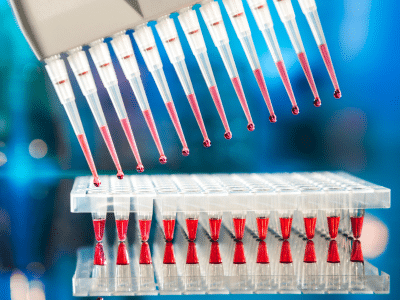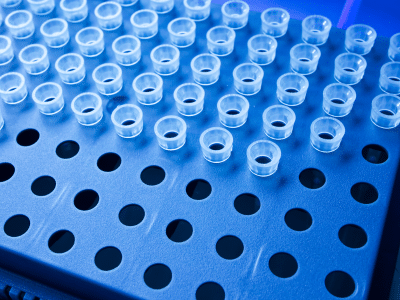The DASRI regulations are complex. To comply with them without forgetting anything, we suggest that you review together which containers are suitable for each DASRI waste produced by your laboratory.
May you still have questions once you have read this blogpost, please share them in the “comments” section below.
The HIW regulations have been put in place to improve the management of hazardous waste. This has also made it possible to reduce the risks associated with waste handling for people working in contact with it.
Indeed, there are waste with infectious risks and others potentially dangerous but without risk of infection. Depending on the waste, the container will not be the same: the color code, the disposal times and the standards will differ for each. The rules do not vary from one facility to another.
What is IHW ?
IHW means Inf
ectious and Hazardous Waste est l’acronyme de Déchets d’Activités de Soins à Risques Infectieux.
According to the DASRI regulations in article R. 1335-1 of the Public Health Code, this is waste from diagnostic, monitoring and preventive, curative or palliative treatment activities in the fields of human and veterinary medicine.
Still according to this article, among these wastes, are subjected to the provisions of the present section those which :
- “either present an infectious risk by virtue of containing viable micro-organisms or their toxins, which, because of their nature, quantity or metabolism, are known or reasonably believed to cause disease in humans or other living organisms; »
- “Or, even if there is no infectious risk, fall into one of the following categories:
- Sharps for disposal, whether or not they have been in contact with a biological product;
- Incompletely used or expired blood products for therapeutic use;
- Human anatomical waste, corresponding to human fragments that are not readily identifiable.»
HIW waste represents an infectious and contamination risk for humans and the environment during its handling and disposal. This is why management is regulated to protect all persons likely to be in contact with this waste (patients, care staff, waste disposal agents, etc.).
They are therefore treated according to two processes: banalization (neutralization of the infectious risk by disinfection in order to orientate the waste towards the traditional household waste channel) or incineration at 850°C.
What is a cytotoxic waste ?
Cytotoxics are substances that act on cells by killing them or altering cell growth. These drugs are mainly used to treat cancer cells. They can also have effects on healthy cells in the body, and therefore pose a risk to patients and caregivers. Appropriate waste management must therefore be put in place.
According to the ministerial circular DHOS/E4/DGS/SD.7B/DPPR n° 2006-58 of 13 February 2006, there are three types of waste generated by anti-cancer treatments:
- “Concentrated anti-cancer drugs: pre-preparation drug, leftover drug, expired drug.
- Soiled anticancer drug waste: medical devices and materials used for administration, bags, tubing, compresses, gloves, etc.
- Waste similar to household waste: unsoiled packaging, unsoiled instruments and PPE (gowns, overboots, masks, etc.)»
Only concentrated anticancer drugs (and filters from the ventilation system of fume hoods and isolators) should be disposed of as non-infectious hazardous waste. Soiled anticancer drug waste can be disposed of as HIW if this results in incineration.
Who is affected by the HIW regulation?
Health professionals are the first to be affected by HIW regulations. However, they are not the only ones, since professionals handling biological liquids or instruments that may be perforating are also concerned.
According to article R. 1335-1 of the Public Health Code, “For the application of the provisions of this section, wastes from teaching, research and industrial production activities in the fields of human and veterinary medicine are considered to be waste from healthcare activities, as well as those resulting from thanatopraxy activities, cosmetic surgery activities, skin tattooing activities and clinical or non-clinical trials conducted on cosmetic products and tattooing products, when they have the characteristics mentioned in 1° or 2° of this article”.
The following professionals must therefore set up a specific management system for the disposal of infectious risk waste:
- GPs and specialists
- Private nurses, company nurses, school nurses
- Dental surgeons
- Mid-wives
- Vets
- Health care, educational or research
- Laboratories
- Pédicures-podologues
- Tattoo-Piercers
- Permanent make up professionals
- Breeders
- Funeral parlours and thanatopractors
- Auto treatment
Wich packaging for IHW?
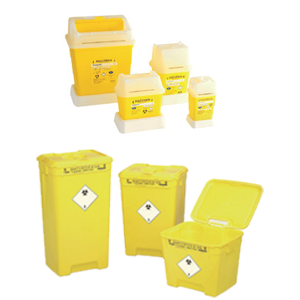
IHW Collectors
Sharp and perforating
Needle, pump body + mounted needle, syringe + mounted needle, scalpel blade, disposable scalpel, lancet, glass blade, glass pipette, etc.
Norms :
- EN-ISO23907-1:2019
Disposal time:
- < 5 Kg per week : 3 months
- entre 5 and 100 Kg per week : 1 week
- > 100 Kg per week : 3 days
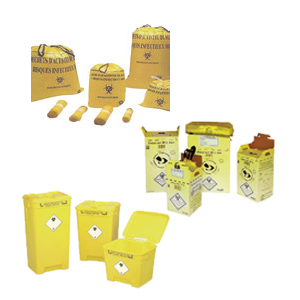
HIW bags, cardboxes and drums
Soft and dry, packaged liquids
Full collector, pump body, syringe, wiping paper, cotton, compress, mask, empty blood bag
Norms :
- NFX30-507:2018
- NFX30-501
Disposal time :
- < 5 Kg per week : 3 months
- entre 5 and 100 Kg per week : 1 week
- > 100 Kg per week : 3 days
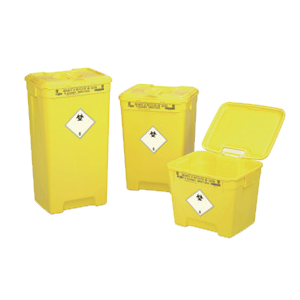
IHW drums
Human sampling
Not identificable human piece
Norms :
- NF X30-511 european norm EN ISO 23907
Disposal time :
- < 5 Kg per week : 3 months
- entre 5 and 100 Kg per week : 1 week
- > 100 Kg per week : 3 days

IHW Jerrican
Liquid IHW
Contaminated liquid : automat effluent, stain, etc.
Norms :
- NFX30-506
Disposal time :
- < 5 Kg per week : 3 months
- between 5 and 100 Kg per week: 1 week
- > 100 Kg per week : 3 days
Wich container for waste witthout any infection risk ?
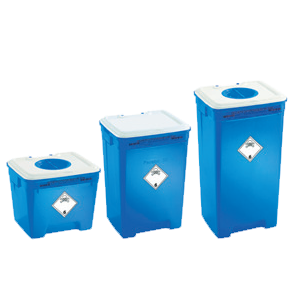
Cytotoxic drums
Cytotoxics
Anticancer medicaments
and soiled material
Norm :
- DHOS from2006 Feb13th
Disposal time :
- None
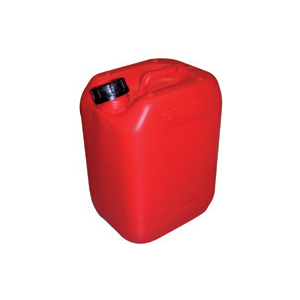
Jerrican
Liquid chemical effluents
Reagents, Acids, Bases ,etc.
Norm:
- Environment care code
- Work code
Disposal time :
- None
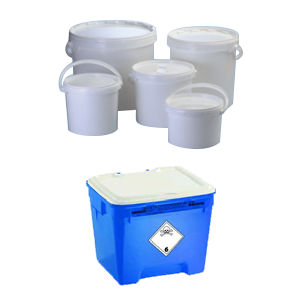
Buckets and blue containers
Chemicals
Packaging, glassware and PPE soiled with chemicals, etc.
Norms:
- Environment care code
- Work code
Disposal time:
- None
What you mustn’t forget about IHW
- it stands for Infectious and Hazardeous Waste
- IHW regulation applies both to human and animal health
- HIW and non-infectious hazardous waste represent a significant contamination risk,you must handle them with caution.
- Each waste item must be disposed of in a suitable container (size, shape, packaging, colour).


